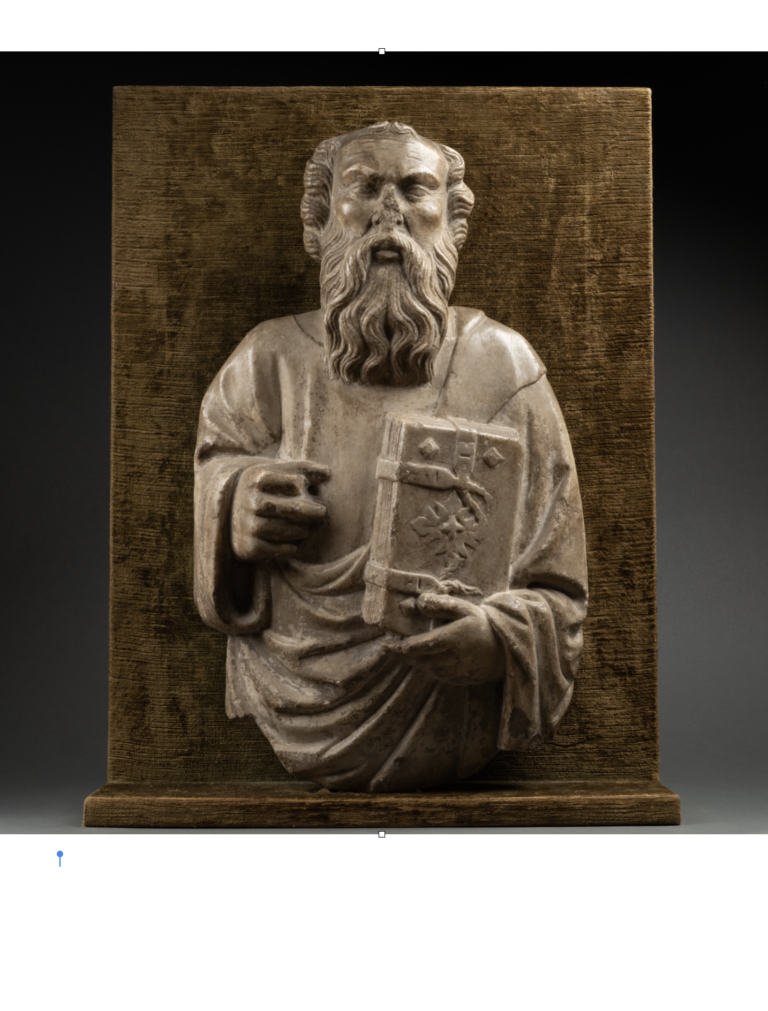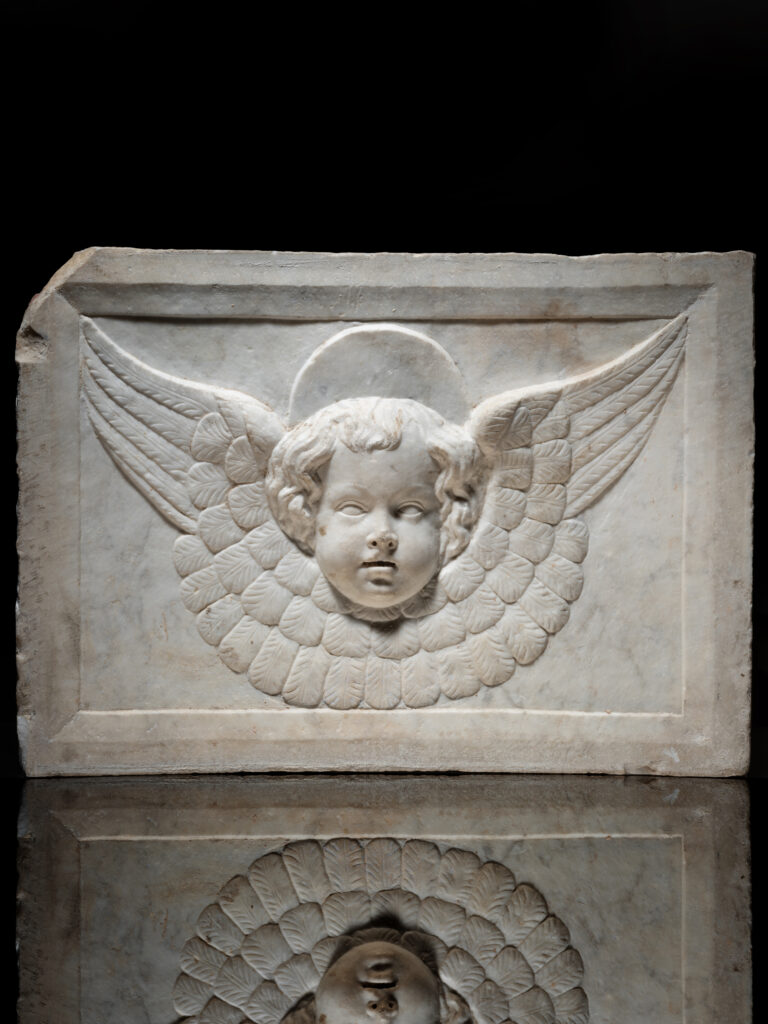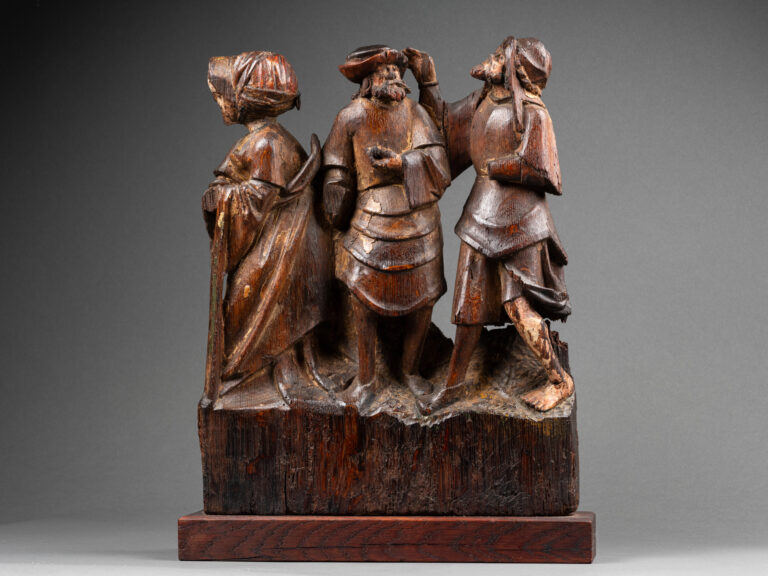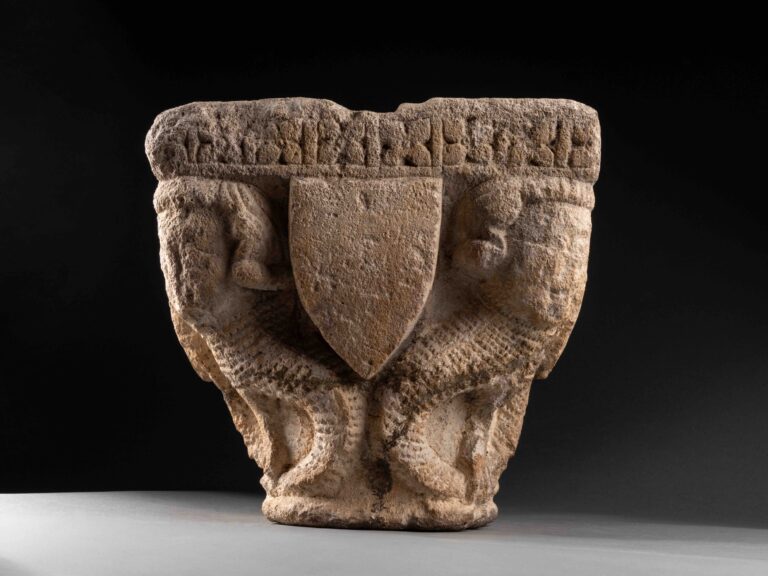At the center of the group, Christ stands upright, leaning against the column, his wrists bound behind his back, his left leg slightly bent; a beautiful elongated head framed by long hair. The quality of craftsmanship is remarkable in the treatment of bodies, expressive faces, and fashionable costumes. The masses are well balanced, and all details are clearly defined. The rich and refined polychromy, combining vibrant colors with the brilliance of gold, specifies and completes the sculptor’s work.
The face of Christ demonstrates great skill in its expression of obvious nobility in his contained pain. Devoid of any dramatic gestures, Christ appears singularly silent, almost serene. His face, profoundly gentle and sad, very slightly tilted to the left, renders the intensity of emotion palpable without relying on expressiveness. With fixed eyes and barely parted lips, he contributes to making this Christ of pity more touching than poignant, both magnified and profoundly human through a perfectly balanced mixture of realistic details and quasi-abstract elements. He looks kindly upon the viewer, inviting imitation and prayer. The two executioners flanking him adopt attitudes suggesting movement and strength; their extravagant attire contrasts with the semi-nude body of Christ, dressed only in an ancient-style loincloth. In this image of devotion, where action is suspended, the artist highlights the delicate figure of Christ opposed to the cruelty of his torturers. The bright colors of the executioners’ clothing stand out against the whiteness of Christ’s loincloth. This violent contrast highlights the purity of the Sufferer against the cruel ignorance of his detractors.
This work is fully part of Brabant’s sculptural production. The Flemish Renaissance is perceptible in the expressiveness, theatrical attitude of the figures with powerful anatomies, as well as in the column surmounted by a Corinthian capital inspired by antiquity.
The executioner to the left of Christ wears a short truss cut into strips and a voluminous codpiece, which was in fashion until 1580, thus allowing the work to be dated to the mid-16th century.

In the Middle Ages, clothing was far from insignificant. It was an indicator of social status, good taste, education, or vulgarity, stinginess. It was used to distinguish the good Christian from the excluded.
The use of anachronistic costumes is an iconographic convention for certain sacred figures, such as Christ or the apostles, who are traditionally dressed in ancient garb and adorned with tunics, loincloths, or sandals, like the Savior in this sculpture. These elements serve to refer the observer to the past, to authority, to dignity. The almost ancient nudity of Christ here contrasts with the contemporary attire of his executioners, dressed in tight-fitting and gilded hosiery, short doublets, and fashionable voluminous codpieces.
Concrete details and picturesque costumes reveal a typical taste of Brabantine works, but also of late Gothic art attached to expressive and narrative values.
This group was part of a set depicting the Passion of Christ and probably occupied the part to the right of the Crucifixion. This representation portrays Christ at a particularly moving moment, conducive to meditation. The popularity of the flagellation is part of an unprecedented development of iconographic cycles inspired by the Passion, from the arrest of Christ to his resurrection. It is one of the most frequently depicted subjects, along with the Ecce Homo, the Pieta, and the Entombment. By depicting the psychological pain, the passion of Christ invites the faithful in turn to meditate on Christ’s sacrifice, on his sufferings, and on those of mankind, thus constituting one of the most effective and prized subjects of the spirituality in vogue at the end of the Middle Ages.

Under the rule of the dukes of Burgundy and the Habsburgs, the former Low Countries experienced an exceptional economic boom in the 15th and 16th centuries, fostering a flourishing artistic activity within the major centers of the region. This was notably the case in Mechelen, Antwerp, and Brussels, which specialized in the production of large wooden altarpieces, depicting episodes from the life of Christ and the Virgin. In the 16th century, Antwerp became the main port of Europe and the hub of a trade, one of whose essential components was the market for art and luxury objects. Around 1500, the production of altarpieces became massive, explained by several factors. On one hand, Antwerp sculptors and painters, belonging to the guild of Saint Luke unlike the Brussels artists, could collaborate more easily, as their production was strictly regulated in terms of wood quality and polychromy. On the other hand, Antwerp production was done in series, in advance, to be subsequently placed on the market. This offered greater freedom while allowing for standardization aimed at increasing the number of models produced. Finally, sculptors and painters were often affiliated with entrepreneurs responsible for selling the works wholesale to couriers, who then distributed the works throughout Europe. Guilds played a central role in this specialized production. They rigorously organized creation, precisely defining each technical element, from the choice of wood to that of pigments, and also determined who was responsible for which task. Each city could affix a certification mark on works created under its auspices, according to the rules it had established. The most famous of these marks is probably the Hand of Antwerp, which appeared around 1470 and is found on both sculpted elements and the very case of the altarpieces. Medieval sculptors from Antwerp were required to become members of the Guild of Saint Luke and had to abide by its regulations.
Despite the absence of iron marks, the work corresponds to a certain peak of Brabant workshops, combining quality materials, intensive production, and mastery of style. All indications, especially the costumes of the characters, agree to date the flagellation before 1580. The composition, elaborate costumes, finely sculpted, as well as the variety of physiognomies and attitudes of the characters, are remarkable. The increasing number of altarpieces at the end of the Middle Ages and the 16th century reflects the evolution of piety in the former Low Countries, the cradle of the devotio moderna seeking a direct connection with the divine. While the narrative power of statuary is more restricted, its ability to embody biblical characters is singularly powerful, through its three-dimensional character, scale, and search for realism, often reinforced by polychromy.
In the domestic sphere, the contemplation of religious images facilitates personal meditation and offers access to spiritual experience. Lay or religious sponsors could install modest-sized altarpieces in an oratory or simply in a room, on a sideboard covered with a cloth serving as a private altar.
Brabantine altarpiece groups represent a pinnacle of Flemish sacred art. Their creation was the result of a tumultuous but artistically rich period, where spirituality and creativity intertwined to produce works that transcend time.
Related Literature:
- M. Buyle and C. Vanthillo, Retables Flamands et Brabançons dans les Monuments Belges, Brussels, 2000
- G. Derveaux – Van Ussel, Retables en bois, Bruxelles, 1977, Musée Royaux d’art et histoire. Guide du Visiteur).
- Huysmans ed., ” La sculpture des Pays-bas méridionaux et de la Principauté de Liège XVe et XVIe siècles “, 1999.
- Madeleine Lazard, « Le corps vêtu : signification du costume à la Renaissance », in Le Corps à la Renaissance. Actes du XXXe colloque de Tours, 1987, é, Paris, Amateurs de Livres, 1990, p. 77-94
- S. Guillot de Suduiraut, Sculptures brabançonnes du musée du Louvre, Bruxelles, Malines, Anvers, XVe-XVIe siècles, Paris, 2001
- H. Nieuwdorp (ed.), Antwerpse retabels, 15de-16de eeuw, exhibition catalogue, Museum voor Religieuze Kunst Antwerpen, 1993
- P. Williamson, Netherlandish Sculpture: 1450-1550, cat. Victoria and Albert Museum, London, 2002






